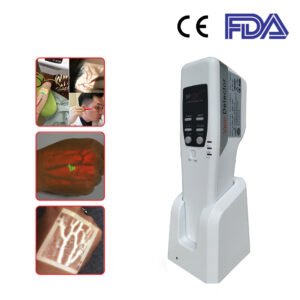Efficacy of Vein Finder to Facilitate IV Contrast
Intravenous (IV) contrast is an iodine-based colorless liquid. The contrast is delivered into your body through a small plastic tube known as an intravenous cannula, which is placed into a vein in your arm by a nurse or radiographer who is experienced in performing this procedure. This will result in minor discomfort, usually no more than taking blood from your arm. The amount of IV contrast required varies, usually in the range of 30–120mls, depending on your body size and type of CT scan requested.
The benefit of administering intravenous contrast for a CT examination is enormous. The use of IV contrast greatly improves the accuracy of the examination and assists in excluding many life-threatening conditions, such as cancer. IV contrast is mainly used to highlight differences between soft tissues which would otherwise look the same.
One of the most common means for diagnosis is through medical laboratory testing, which primarily uses venous blood as a sample. This requires an invasive method by cannulation that needs proper vein selection.
The use of a vein finder would help the phlebotomist to easily locate the vein, preventing possible pre-analytical error in the specimen collection and even more discomfort and pain to the patient.
In fact, blood drawing can become very challenging due to the skin condition of the elderly. Indeed, their skin turns more thin, dry, and fragile. Not only that but The blood vessels also become more delicate, so a failure in venipuncture can cause these fragile blood vessels to break easily. Thus, creating bruising, swelling, or even bleeding under the skin.
The SIFVEIN-5.2 is designed specifically for these cases where it’s difficult to find the vein or it needs more concentration and cautiousness. No matter how old the patient is or his skin color or obesity level, the SIFVEIN-5.2 makes it possible to observe veins clearly in a depth of 10 mm under the skin.
Moreover, it comes with a depth recognition mode which improves the judgment of the vein’s depth and 3 colors (Red, green, and white ) that can be switched at will depending on the light of the room and the patient’s skin tone so that the vein becomes more visible, easier to access and the clinical accuracy gets higher. Thus, banning any possible fail diagnosis and preventing discomfort, stress, and pain to the senior patients.
Vein detectors, such as the accurate and clear vein illuminator SIFVEIN-5.2 by SIFSOF, have proved, therefore, their efficiency during this complicated IV process.
The SIFVEIN-5.2 is a portable hands-free, non-invasive device that projects near-infrared light on the patient’s skin, mapping out the desired veins in the area, which are not otherwise visible to the naked eye.
To conclude, if a vein finder is used, the venipuncture technique would be much easier. Phlebotomists, nurses, or doctors can ensure the procedure’s effectiveness while reducing the number of failed needle attempts and patient pain.
Vein finders are of paramount importance, in all medical fields, in order to make IV access easier, safer, and less painful.
References : CT Intravenous Contrast & Consent

